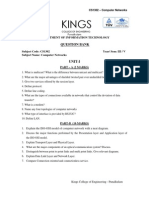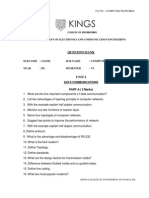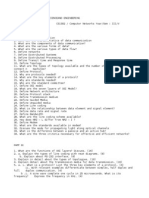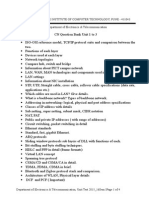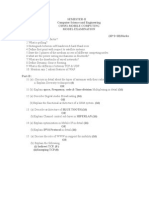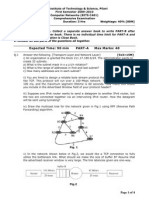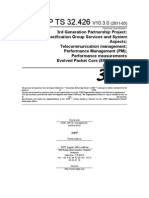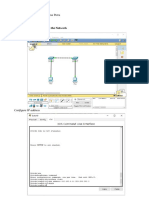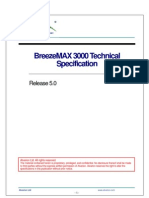Question Bank
Question Bank
Uploaded by
K R OFFSET PRINTERSCopyright:
Available Formats
Question Bank
Question Bank
Uploaded by
K R OFFSET PRINTERSCopyright
Available Formats
Share this document
Did you find this document useful?
Is this content inappropriate?
Copyright:
Available Formats
Question Bank
Question Bank
Uploaded by
K R OFFSET PRINTERSCopyright:
Available Formats
www.rejinpaul.
com
PRATHYUSHA ENGINEERING COLLEGE
DEPARTMENT OF ELECTRONICS AND COMMUNICATION
QUESTION BANK
EC8551-COMMUNICATION NETWORKS
UNIT1-FUNDAMENTALS AND LINK LAYER
PART-A
1. Define the term protocol and mention its key elements.
2. Identify the functions of Data Link Layer.
3. List the advantages of Fiber optics cable.
4. A network with bandwidth of 10 Mbps can pass only an average of 12,000 frames per
minute with each frame carrying an average of 10,000 bits. What is the throughput of
this network?
5. Explain the services provided by Transport layer.
6. Explain the different types of transmission mode.
7. What are the three fundamental characteristics that determine the effectiveness of a
data communication system?
8. Write the need of Transmission media? And Write their types?
9. List the advantages of Star topology?
10. Draw the flow diagram for stop-and-wait protocol?
11. What are the three necessary criteria for an effective and efficient network?
12. Draw and mention the operation of each field in Byte counting Approach frame
format
13. Assuming a framing protocol that uses bit stuffing, show the bit sequence transmitted
over a link when the frame contains the bit sequence.
1111011111101001111101011111110. Mark the stuffed bits.
14. Discuss in brief five components of data communication system.
PREPARED BY:Mr.E.DILLIRAJ, AP/ECE
PRATHYUSHA ENGINEERING COLLEGE Page 1
Download Rejinpaul App from Playstore
www.rejinpaul.com
15. Describe the parameters used to measure network performance.
16. Explain the functions provided by Presentation Layer
17. List the advantages of mesh topology?
18. Consider a 32 bit block of data 10100111 11011101 0101001 10101001
10111010 that has to be transmitted using odd parity. Make use of two dimensional
parity and determine the transmitted bit stream?
19. What is hamming distance?
20. Differentiate Go Back –n and Selective repeat protocol.
PART-B
1. Explain the Network Support layers in OSI model.
2. (i) The code 11110101101 was received using hamming encoding algorithm. What is
the original code sent? Use odd parity.
(ii) Explain checksum with an example.
3. (i) Explain how framing is done using byte oriented protocols.
(ii) Explain stop and wait protocol for normal operation and ACK lost case.
4. Discuss the User support Layers in detail.
5. Explain in detail
(i) Categories of topologies
(ii) Types of network
6. With a neat sketch explain about
(i) Guided medias
(ii) Unguided medias
7. (i) Explain in detail about Building a Computer Network.
(ii) Obtain the 4-bit CRC code for the data bit sequence 10011011100 using the
polynomial x4+x2+1.
8. With a neat sketch, explain the architecture of an OSI layer model.
9. (i) Suppose we want to transmit the message 1011 0010 0111 and protect it from
errors using the CRC polynomial x4 +x2 +1. Use polynomial long division to
determine the message that should be transmitted. Suppose the leftmost bit of the
message is inverted due to noise on the transmission link. What is the result of the
receiver’s CRC calculation? How does the receiver know that an error has occurred?
(ii) Explain the algorithm used for reliable transmission and flow control.
PREPARED BY:Mr.E.DILLIRAJ, AP/ECE
PRATHYUSHA ENGINEERING COLLEGE Page 2
Download Rejinpaul App from Playstore
www.rejinpaul.com
10. (i) Discuss in detail about the network performance measures.
(ii) Explain selective-repeat ARQ flow control method.
UNIT 2- MEDIA ACCESS & INTERNETWORKING
PART-A
1. Compare 802 with OSI model.
2. Illustrate the operation of Ethernet format with neat sketch.
3. List the types of stations in 802.11 architecture and explain each station operation.
4. Categorize the media access in data link layer.
5. What do you mean by 1-persistant? Explain with a neat sketch.
6. Examine the networks involved in Bluetooth architecture.
7. Write short notes on Fast Ethernet.
8. Construct the packet format for 6LowPAN.
9. List out the applications of Zigbee protocol.
10. Identify the error if any in the following IP address.
(i) 11.56.045.78
(ii) 75.45.301.14
11. Explain the process of p-Persistent method with neat sketch.
12. Show the protocol architecture of 802.11.
13. Write short notes on Pure Aloha.
14. Inspect the operation of PICONET.
15. Illustrate the routing concepts involved in 6LoWPAN.
16. A block of addresses is granted to a small organization. We know that one of the
addresses is 205.16.37.39/28. What is the first address and last address in the block
and also find the number of addresses?
17. What do you meant by switching?
18. Identify the Class and represent the netid of the following IP Address:
(i) 110.34.56.45
(ii) 212.208.63.23
19. What do you understand by CSMA protocol?
20. List the important components for ZIGBEE protocol.
PREPARED BY:Mr.E.DILLIRAJ, AP/ECE
PRATHYUSHA ENGINEERING COLLEGE Page 3
Download Rejinpaul App from Playstore
www.rejinpaul.com
PART-B
1. (i)ExplainthefunctioningofwirelessLANorIEEE802.11indetail.
(ii) Examine the different implementations of Fast Ethernet and Gigabit Ethernet in
detail.
2. (i) Explain the different switching techniques in detail.
(ii) Discuss about Bluetooth Technology in detail.
3. (i) Explain in detail about Standard Ethernet and 10 Gigabit Ethernet.
(ii) Elaborate about 6LoWPAN with its packet format and Routing techniques.
4. (i) Discuss in detail about IPv4 packet format and its address representation with an
example.
(ii) Elaborate the ICMP in detail.
5. Explain in detail about packet switching techniques with its suitable example.
6. (i) Discuss in detail about ICMP and its message types.
(ii) Suppose all of the interfaces in each of three subnets are required to have the
prefix 223.1.17/24. Also suppose that Subnet 1 is required to support at least 60
interfaces, Subnet 2 is to support at least 90 interfaces, and Subnet 3 is to support at
least 12 interfaces. Provide three network addresses that satisfy these constraints.
7. (i) Explain the datagram format of IPv4.
(ii) Explain in detail about Datagram and Virtual-Circuit approach for Packet
switching with an example.
8. (i) Explain in detail about Mobile IP.
(ii) Discuss in detail about 6LoWPAN and Zigbee Network.
9. (i) Explain Class based addressing in IP address and analyze the range of addresses
available in each class.
(ii) Discuss about classless addressing in IPv4 with a suitable example.
10. With neat Sketch, explain about IP service model, Packet format, Fragmentation and
reassembly.
UNIT 3-ROUTING
PART-A
1. Define Routing.
2. What is Multicast Routing?
3. What are the metrics used by routing protocols?
PREPARED BY:Mr.E.DILLIRAJ, AP/ECE
PRATHYUSHA ENGINEERING COLLEGE Page 4
Download Rejinpaul App from Playstore
www.rejinpaul.com
4. What is Border Gateway Protocol (BGP)?
5. Define Intradomain multicast routing and Interdomain multicast routing.
6. Compare forwarding table and Routing table.
7. Illustrate the concept of fragmentation and reassembly.
8. Why is IPv4 to IPv6 transition required?
9. Write short notes on Unicast Routing Protocol.
10. Explain about link state Algorithm.
11. Discuss about open shortest path first protocol.
12. Discuss about RIP implementations.
13. What is Flooding?
14. Write short notes on IGMP.
15. Classify different Routing algorithms.
16. Explain about Count-to-Infinity Problem.
17. List the Benefits of OSPF.
18. Inspect the salient features of IPv6.
19. Compare IPv4 and IPv6.
20. Identify the error is present or not in the following IPv6 Addresses:
(i) A456:04FF::F678:001F
(ii) 0000:::FFFF
PART-B
1. Consider the network shown in figure below. Compute the shortest path from C to all
other nodes using link state algorithm. Also update the forwarding table of node C.
2. (i) For the network shown in Figure below, give global distance–vector.
When
(a) Each node knows only the distances to its immediate neighbours.
(b) Each node has reported the information it had in the preceding step to its
immediate neighbours.
PREPARED BY:Mr.E.DILLIRAJ, AP/ECE
PRATHYUSHA ENGINEERING COLLEGE Page 5
Download Rejinpaul App from Playstore
www.rejinpaul.com
(c) Step (b) happens a second time:
(ii)Explain IPv6 packet header format with neat sketch.
3. (i) Explain the operation of Protocol-Independent Multicast (PIM).
(ii) Outline the need of Distance Vector Multicast Routing Protocol (DVMRP).
4. Discuss in detail about:
(i) Routing Information Protocol (RIP)
(ii) Open Shortest Path First (OSPF)
5. If we have the forwarding tables shown in table belowfor nodes A and F, in a network
where all links have cost 1. Give a diagram of the smallest network consistent with
these tables.
6. Explain the strategies involved in Transition of IPv4 to IPv6 in detail with neat
sketch.
7. (i) Explain the function of Routing Information Protocol (RIP).
(ii) Draw the IPv6 packet header format.
8. (i) Explain the operation of Protocol-Independent Multicast (PIM).
(ii) Outline the need of Distance Vector Multicast Routing Protocol (DVMRP).
9. Briefly explain the BGP used for Inter domain routing.
10. Explain multicast routing protocol DVMRP.
PREPARED BY:Mr.E.DILLIRAJ, AP/ECE
PRATHYUSHA ENGINEERING COLLEGE Page 6
Download Rejinpaul App from Playstore
www.rejinpaul.com
UNIT 4-TRANSPORT LAYER
PART-A
1. Distinguish between Connectionless and Connection oriented protocols in Transport
layer.
2. List the different phases used in TCP connection.
3. How do fast retransmit mechanism of TCP works?
4. What are the approaches used to provide a range of Quality of Services (QOS)?
5. What do you mean by slow start in TCP congestion Control?
6. List some of the QOS parameters of transport layer.
7. Suppose you are designing a sliding window protocol for 1.5 Mbps point-point link.
This has one way latency of 1.5 seconds. Assuming each frame carries 10KB of data,
what is the maximum number of bits required for the sequence number if SWS=RWS.
8. What do you mean by QOS?
9. Draw the UDP header format with neat sketch.
10. List the flags used in TCP header format and explain about each flag.
11. What do you mean by the port number?
12. List the services provided by transport layer protocol?
13. Differentiate between TCP and UDP.
14. Define Congestion Control.
15. Compare flow control verses congestion control.
16. Suppose TCP operates over 10-Gbps link. Assuming the full bandwidth continuously
how long would it take the sequence number to wrap around completely? If the
sequence number space adequate.
17. Explain the TCP connection establishment using with three-way handshaking.
18. Inspect the features of TCP protocol.
19. Explain briefly about Leaky Bucket algorithm.
20. What are the reservation styles involved in RSVP?
PART-B
1. (i) Explain in detail about TCP congestion control techniques with neat sketch
(ii) Explain UDP packet format with neat sketch and UDP checksum with an
example.
2. (i) Explain in detail about TCP connection Management.
PREPARED BY:Mr.E.DILLIRAJ, AP/ECE
PRATHYUSHA ENGINEERING COLLEGE Page 7
Download Rejinpaul App from Playstore
www.rejinpaul.com
(ii) Inspect the flags used in TCP segment format in detail.
3. (i) Explain various fields of the TCP header and protocol operation.
(ii)Compare TCP and UDP
4. (i) Explain the services provided by the TCP.
(ii)The following is a dump of a TCP header in Hexadecimal format.05320017
00000001 00000000 500207FF 00000000 Determine the Source port number,
Destination port number, Sequence number, Acknowledgement number, Length of
the header, Type of the segment and Window size?
5. Explain three ways of connection termination in TCP using state transition diagram.
6. Suppose TCP operates over 10-Gbps link. Assuming the full bandwidth continuously
how long would it take the sequence number to wrap around completely? If the
sequence number space adequate.
7. Explain any one TCP congestion avoidance mechanism.
8. Brief about the approaches used to provide QoS support.
9. (i) Explain how TCP manages a byte stream.
(ii) Identify and explain the states involved in TCP.
10. (i) Discuss the operations of UDP with neat sketch.
(ii) Define UDP. Explain UDP checksum with an example.
UNIT 5-APPLICATION LAYER
PART-A
1. Name four factors needed for a secure network.
2. List the two types of DNS messages:
3. What are the three types of web documents?
4. What are the three domains of DNS?
5. What is the difference between active document and a dynamic document?
6. What are the two parts of addressing system used in SMTP?
7. What is MIME?
8. What is Post office protocol (POP)?
9. What are the four types or groups of HTTP header?
10. Define www or World Wide Web.
11. List the advantages of IMAP over POP.
12. Distinguish between application programs and application protocol.
PREPARED BY:Mr.E.DILLIRAJ, AP/ECE
PRATHYUSHA ENGINEERING COLLEGE Page 8
Download Rejinpaul App from Playstore
www.rejinpaul.com
13. What is non persistent connection in HTTP?
14. What is the function of proxy server in HTTP?
15. What is encryption and decryption?
16. What is the relation between plaintext and cipher text?
17. Define cryptography. State the types of cryptographic algorithms?
18. What is monoalphabetic and polyalphabetic substitution?
19. What is transpositional encryption?
20. What is RSA encryption? (OR) Write about public key encryption?
PART-B
1. Explain Domain Name System (DNS).
2. Discuss the components of an email system and the protocols used.
OR
Explain electronic mail (e - mail) or SMTP, MIME, POP.
3. (i) Write short notes on HTTP.
(ii) Write short note on Internet Message Access Protocol (IMAP).
4. Define Encryption/ Decryption and write their types with examples.
5. Explain in detail DES encryption scheme with an example and what are the
drawbacks of DES algorithms? [NOV-04] OR Explain symmetric key cryptography
with a suitable example.
6. Explain the principle of RSA algorithm and how the public and secret keys are
derived? [April -04] OR Explain asymmetric key cryptography with suitable example.
7. Distinguish between conventional and public key encryption
8. Discuss in detail about Client/ Server Programming.
9. Explain in detail about WWW.
10. (i) Discuss in detail about Network Security.
(ii) Elaborate about Firewall.
PREPARED BY:Mr.E.DILLIRAJ, AP/ECE
PRATHYUSHA ENGINEERING COLLEGE Page 9
Download Rejinpaul App from Playstore
You might also like
- CS1302 - Computer NetworksDocument5 pagesCS1302 - Computer Networkslm_zakaria4420No ratings yet
- CS6551 Computer NetworksDocument7 pagesCS6551 Computer NetworksMogili sivaNo ratings yet
- CS1302 Computer NetworksDocument8 pagesCS1302 Computer Networkspuspa2009No ratings yet
- Question Bank Unit 1-2Document3 pagesQuestion Bank Unit 1-2Vikas ManchalNo ratings yet
- Ec2352 Computer Networks Question Bank CNDocument4 pagesEc2352 Computer Networks Question Bank CNMuhamed HajaNo ratings yet
- EC8551 Revision QuestionDocument3 pagesEC8551 Revision QuestionRaja PirianNo ratings yet
- CS2361 CN Im 2013 PDFDocument2 pagesCS2361 CN Im 2013 PDFsaravana102030No ratings yet
- QB-CN-1Document8 pagesQB-CN-1sandeep rangariNo ratings yet
- EI8074-Computer NetworksDocument12 pagesEI8074-Computer NetworksKarthik KeyanNo ratings yet
- Unit - 1 (Introduction of Computer Networks)Document5 pagesUnit - 1 (Introduction of Computer Networks)Abhinavv GandhiNo ratings yet
- EC6802-wn - QB - With Out BloomsDocument12 pagesEC6802-wn - QB - With Out BloomsBabiyola AntonyNo ratings yet
- 7 CN - Question BankDocument4 pages7 CN - Question Bankmmahesh87656No ratings yet
- HPCN QuestionsDocument2 pagesHPCN Questionssmsekar100% (1)
- CN Question BankDocument3 pagesCN Question BankTejas AdityaNo ratings yet
- MPCDocument5 pagesMPCStella SarkunamNo ratings yet
- NC7101-High Performance NetworksDocument7 pagesNC7101-High Performance NetworkssanthiNo ratings yet
- CN Question BankDocument3 pagesCN Question BankJanvi GabaniNo ratings yet
- Computer Network-1 IA Question BankDocument5 pagesComputer Network-1 IA Question BankVeena GadadNo ratings yet
- CN QuestionsDocument4 pagesCN Questionsashish3686No ratings yet
- Computer Networks Year Question BankDocument5 pagesComputer Networks Year Question Bankakhilek100% (1)
- V.M.K.V Engineering College Vinayaka Missions University Department of Information Technology IV YEAR (BATCH - 2006-2010) Mobile ComputingDocument5 pagesV.M.K.V Engineering College Vinayaka Missions University Department of Information Technology IV YEAR (BATCH - 2006-2010) Mobile ComputingpocketoxyNo ratings yet
- Question BankDocument12 pagesQuestion BankMahu DNo ratings yet
- DCN 2171008 AssignmentDocument4 pagesDCN 2171008 AssignmentRAMSHI CHETARIYANo ratings yet
- CN Question BankDocument4 pagesCN Question BankSeemon BhadoriaNo ratings yet
- CN Question BankDocument5 pagesCN Question BankPavan Kumar0% (1)
- Network Routing and SwitchingDocument3 pagesNetwork Routing and SwitchingKawsar AliNo ratings yet
- B.E./B.Tech. Degree Examination, April/May 2011 Sixth Semester - Electrical and Electronics Engineering Cs 2363 - Computer NetworksDocument5 pagesB.E./B.Tech. Degree Examination, April/May 2011 Sixth Semester - Electrical and Electronics Engineering Cs 2363 - Computer NetworksannamyemNo ratings yet
- K. K. Wagh Polytechnic, Nashik.: Department of Computer TechnologyDocument1 pageK. K. Wagh Polytechnic, Nashik.: Department of Computer Technology16FYCM-IDhakane Aditya ArunNo ratings yet
- Computer NetworksDocument9 pagesComputer NetworkspriyaaramNo ratings yet
- Ec3401 2marksDocument3 pagesEc3401 2marksbhuvanaNo ratings yet
- Question BankDocument3 pagesQuestion BankTikendrajit SarmahNo ratings yet
- Information Technology V Sem Set 2Document2 pagesInformation Technology V Sem Set 2aniruthgsabapathyNo ratings yet
- 7 Sem SyllabusDocument37 pages7 Sem Syllabusdheerajnarula1991No ratings yet
- 10M CN Question BankDocument2 pages10M CN Question Bankvsureshkumar1116No ratings yet
- DC Imp QuestionsDocument3 pagesDC Imp QuestionsdeekshachennamshettyNo ratings yet
- 7bite2a External IIDocument1 page7bite2a External IISankareswari KaverimanianNo ratings yet
- CN or TH QuestionsDocument4 pagesCN or TH QuestionsshraddhaNo ratings yet
- CN PyqsDocument3 pagesCN PyqsVVLNo ratings yet
- CST303 Computer Networks, December 2021Document3 pagesCST303 Computer Networks, December 2021Anas AnsarNo ratings yet
- Answer ALL Questions: PART B (5 X 16 80)Document17 pagesAnswer ALL Questions: PART B (5 X 16 80)Ahmed Eid Abd ElRaoufNo ratings yet
- CN Question BankDocument3 pagesCN Question Bank22r11a05t5No ratings yet
- Dc792tutorial AssinmentDocument5 pagesDc792tutorial AssinmentKanu GuptaNo ratings yet
- Cat II Question BankDocument2 pagesCat II Question BankdakubaiNo ratings yet
- 18it502 - DCCN - Question Bank-1Document6 pages18it502 - DCCN - Question Bank-1SHANMUGAM SNo ratings yet
- Cst303 Computer Networks, December 2022Document2 pagesCst303 Computer Networks, December 2022rishilalinfoNo ratings yet
- Ns Question BankDocument18 pagesNs Question BankSOBANA RAJESHNo ratings yet
- AMIE-Computer Network Old Question SortedDocument10 pagesAMIE-Computer Network Old Question Sortedsandeepharidas100% (3)
- CN QuestionsDocument5 pagesCN Questions21131a03a5No ratings yet
- CS2402 QB mpc2Document10 pagesCS2402 QB mpc2Prabhavathi AadhiNo ratings yet
- Ec2352 Computer Networks Question BankDocument5 pagesEc2352 Computer Networks Question BankVignesh SelvamNo ratings yet
- Question Bank Module-1: Computer Networks 18EC71Document4 pagesQuestion Bank Module-1: Computer Networks 18EC71richa100% (1)
- Ec2352 Computer Networks Question BankDocument5 pagesEc2352 Computer Networks Question Bankravi12333No ratings yet
- Cs9251 Mobile ComputingDocument13 pagesCs9251 Mobile ComputingSenthil KumarNo ratings yet
- Computer Network BankDocument2 pagesComputer Network BankAyushiNo ratings yet
- 5G Explained: Security and Deployment of Advanced Mobile CommunicationsFrom Everand5G Explained: Security and Deployment of Advanced Mobile CommunicationsNo ratings yet
- Cisco Certified Network Associate (CCNA) and Cisco Certified Network Professional (CCNP): Mastering Network Automation and Programmability Study GuideFrom EverandCisco Certified Network Associate (CCNA) and Cisco Certified Network Professional (CCNP): Mastering Network Automation and Programmability Study GuideNo ratings yet
- IPTV Delivery Networks: Next Generation Architectures for Live and Video-on-Demand ServicesFrom EverandIPTV Delivery Networks: Next Generation Architectures for Live and Video-on-Demand ServicesSuliman Mohamed FatiNo ratings yet
- DownloadDocument4 pagesDownloadK R OFFSET PRINTERSNo ratings yet
- EC8551 Presentation All UnitDocument189 pagesEC8551 Presentation All UnitK R OFFSET PRINTERSNo ratings yet
- EC8791-Embedded and Real Time Systems UNITS NOTESDocument420 pagesEC8791-Embedded and Real Time Systems UNITS NOTESK R OFFSET PRINTERSNo ratings yet
- Ec8751 Optical Communication Unit I Introduction To Optical FibersDocument94 pagesEc8751 Optical Communication Unit I Introduction To Optical FibersK R OFFSET PRINTERSNo ratings yet
- Rolo de Comando IKODocument61 pagesRolo de Comando IKOCleydson Vieira GomesNo ratings yet
- Draft Specification of Lan Switch: Specification No. Rdso/Spn/Tc/83/2014 Revision 1.0Document27 pagesDraft Specification of Lan Switch: Specification No. Rdso/Spn/Tc/83/2014 Revision 1.0Anonymous MDkp0hnb3lNo ratings yet
- Arctic GPRS EDGE Gateways PDFDocument2 pagesArctic GPRS EDGE Gateways PDFStephen Odon FastoNo ratings yet
- ENSC427 Team6 ReportDocument22 pagesENSC427 Team6 ReportAnonymous TTVlXoNo ratings yet
- Wavecom CommandDocument146 pagesWavecom Commandbloger86No ratings yet
- 3.2.1.7 Packet Tracer - Configuring VLANs InstructionsDocument3 pages3.2.1.7 Packet Tracer - Configuring VLANs Instructionswahyu100% (1)
- H3C S6860 Series Data Center Switches Data Sheet - UpdatedDocument11 pagesH3C S6860 Series Data Center Switches Data Sheet - UpdatedsAuD huSSainNo ratings yet
- Expected Time: 90 Min Part-A Max Marks: 40Document4 pagesExpected Time: 90 Min Part-A Max Marks: 40ChaitanyaLukkaNo ratings yet
- 1850 TSS-5C DatasheetDocument2 pages1850 TSS-5C DatasheetNguyen TrungNo ratings yet
- WWPC World PortsDocument20 pagesWWPC World Portsayesha_malik21No ratings yet
- Mtcre PDFDocument91 pagesMtcre PDFMadhav KarkiNo ratings yet
- A30Document73 pagesA30johncena90No ratings yet
- List Commands 3gDocument4 pagesList Commands 3gNadira ChikhNo ratings yet
- 3GPP TS 24.080Document52 pages3GPP TS 24.080santanameroNo ratings yet
- Frecuencias y Subtonos FRSDocument7 pagesFrecuencias y Subtonos FRSRodrigoNo ratings yet
- PSS 16 - PSS 32 - 1830 Photonic Service Switch - AmtDocument3 pagesPSS 16 - PSS 32 - 1830 Photonic Service Switch - AmtViviana Hernández TiqueNo ratings yet
- Prak KDJK 2 PDFDocument9 pagesPrak KDJK 2 PDFgakoNo ratings yet
- Troubleshooting Tip - Using The FortiGate Sniffer On VLAN InterfacesDocument2 pagesTroubleshooting Tip - Using The FortiGate Sniffer On VLAN InterfacesAlexis Marcano PradaNo ratings yet
- GSM ArchitectureDocument36 pagesGSM ArchitectureKashif AliNo ratings yet
- Full ConfigurationDocument21 pagesFull ConfigurationJulie MarieNo ratings yet
- BSC TimersDocument23 pagesBSC TimersVidya Tripathi50% (2)
- Software Defined NetworkingDocument9 pagesSoftware Defined NetworkingJorge Armando Soto GarcíaNo ratings yet
- Hmi Vu Series Instruction Leaflet: Hmivu06Cunb (Rear View)Document2 pagesHmi Vu Series Instruction Leaflet: Hmivu06Cunb (Rear View)Nelson RibeiroNo ratings yet
- DWDM - CIENA - NAT - 5170 - PlatformDocument6 pagesDWDM - CIENA - NAT - 5170 - PlatformLucas CostaNo ratings yet
- FotinetDocument8 pagesFotinetTrần Đăng KhoaNo ratings yet
- Datasheet Alvarion BreezeMAX Ver 3 5Document15 pagesDatasheet Alvarion BreezeMAX Ver 3 5wall46No ratings yet
- IPv4 Mobility SupportDocument8 pagesIPv4 Mobility SupportseventhsensegroupNo ratings yet
- Chapter 3 Transport LayerDocument112 pagesChapter 3 Transport LayerAliceNo ratings yet
- GSM ArchitectureDocument442 pagesGSM ArchitecturePritam Kumar ChawlaNo ratings yet
- Classless Inter Domain RoutingDocument25 pagesClassless Inter Domain RoutingDeepanshu KaushikNo ratings yet
